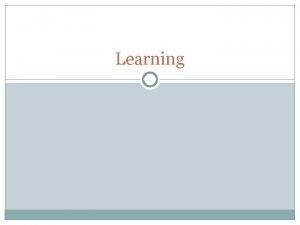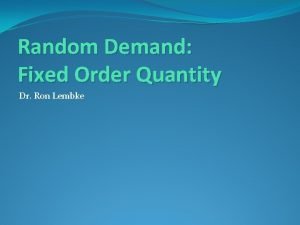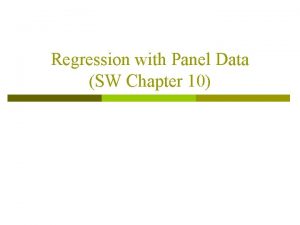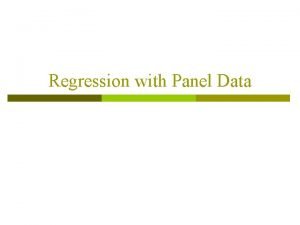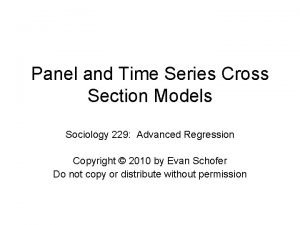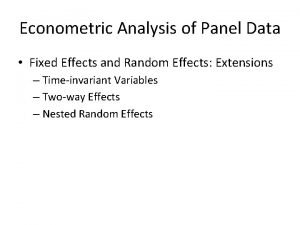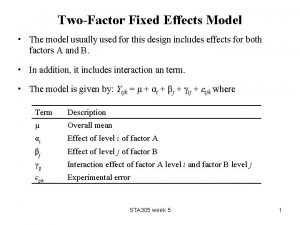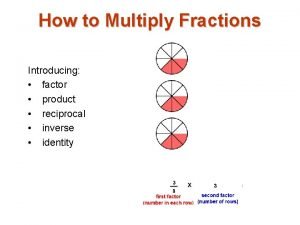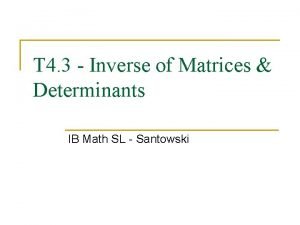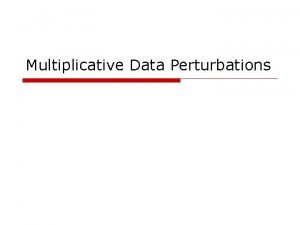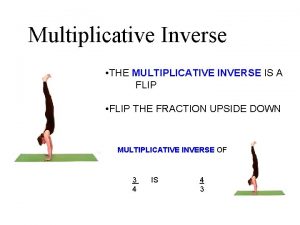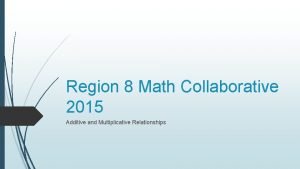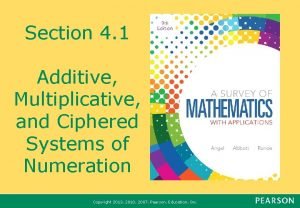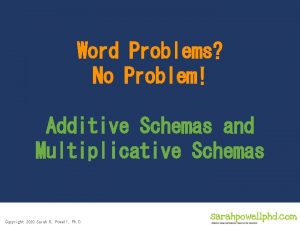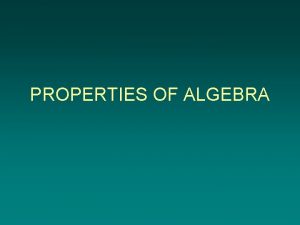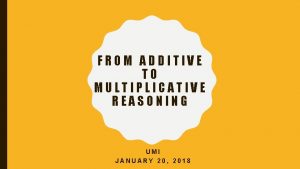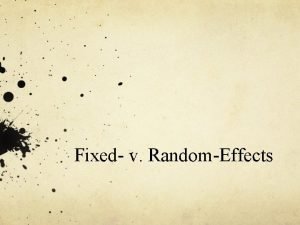Additive and multiplicative effects in a fixed 2











- Slides: 11

Additive and multiplicative effects in a fixed 2 x 2 design using ANOVA can be difficult to differentiate J. A. Landsheer & G. van den Wittenboer

Example two factor ANOVA A, B: arbitrary coded independent variables {-1, 1} l Y: dependent variable l A -1 B +1 -1 4 8 12 +1 8 16 24 12 24 36 2

Motivation * Ability interaction (Y = Performance) Means of the nonadditive relation in the 2 x 2 design of Table 1 and 2 that are produced by a single product term. ANOVA analysis does not show a significant interaction effect (N = 96). 3

Table 1: Exemplary ANOVA Results of 96 Cases. Demonstration of Enlarged Main Effects and no Interaction Effect when testing model Y = A + B + A*B. Source SS df Corrected Model 4125, 954 Intercept 19615, 168 A 2254, 534 1 B 1868, 284 1 A*B 3, 136 1 3, 1 Error 3587, 566 92 Total 27328, 688 96 Corrected Total 7713, 520 Partial eta MS F p. squared 3 1375, 3 35, 3 , 000 , 535 1 19615, 1 503, 0 , 000 , 845 2254, 5 57, 8 , 000 , 386 1868, 2 47, 9 , 000 , 342 , 1 , 777 , 001 38, 9 95 4

Four questions 1. 2. 3. 4. What happened? Why did the ANOVA result not indicate an interaction? Is this a real situation, which can be expected in real experimenting or is it just a simulation artefact? Is there an analysis model that would be more appropriate for this kind of data? How can the researcher decide that his model of analysis is not particularly fitting in this situation? 5

Statistical interpretation: Rejection of the multiplicative model Simulated data: Y = A’ * B’ A’, B’: not directly observed treatment strengths A, B: {-1, +1} There always linear relationships. In a simulation they are known. A’ = A + 3 B’ = B + 3 Y = (A + 3) (B + 3) + error What happened? 6

What happened: diagnosis Suppose l real treatment values A’ (a 1, a 2) l real treatment values B’ (b 1, b 2) l Y = A’ * B’. with n observations in each cell. A -1 +1 B -1 O 2 +1 O 3 O 4 7

Then: Xmeantot = (O 1 + O 2 + O 3 + O 4) / 4. And l SSA = 4 n [( (b 1 + b 2)(a 1 – a 2)) / 4] 2, l SSB = 4 n [( (a 1 + a 2)(b 1 – b 2)) / 4] 2, l SSAB = 4 n [(a 1 - a 2)(b 1 – b 2) / 4] 2. l 8

Illustration of the dependency of the expected mean squares of main factor A on the treatment results b 1 and b 2 l Y = A + B + AB ® ® E[MSA] = n {(b 1 + b 2 +2) (a 1 – a 2)}2/4 E[MSAB] = n {(b 1 - b 2) (a 1 – a 2)}2/4 = 6 l Y = AB ® E[MSA] = n {(b 1 + b 2)(a 1 – a 2)} 2/4 E[MSAB] = n {(b 1 - b 2) (a 1 – a 2)}2/4 = 6 ® l ® Y=A+B E[MSA] = n (2 a 1 – 2 a 2)2/4 = 6 9

Seriousness of the problem ANOVA results of 21. 000 simulations of a combinatory effect Performance = Ability * Motivation. The mean differences between the groups are kept constant (. 5) for ability, while the mean manipulation difference of motivation is varied in 21 steps from 0 to 2. For each step the simulation is repeated 1000 times. 10

Discussion l l l Can this situation arise in real experimenting? Is centering helpful? Sensitivity interactions / main effects – Wahlsten: sample 7 to 9 larger – Mc. Clelland & Judd: efficiency about 20% l l l Is Multiple Regression a better approach? Measurement of the independent variables Extended experimenting 11
 Fixed function logic
Fixed function logic Module 27 operant conditioning
Module 27 operant conditioning Variable interval
Variable interval Fixed interval vs fixed ratio
Fixed interval vs fixed ratio Fixed order quantity vs fixed time period
Fixed order quantity vs fixed time period Time fixed effects
Time fixed effects Panel regression
Panel regression Advanced regression models
Advanced regression models Time fixed effects
Time fixed effects Fixed effects model
Fixed effects model What is the reciprocal of 14 in fraction form
What is the reciprocal of 14 in fraction form Can matrices be divided
Can matrices be divided



